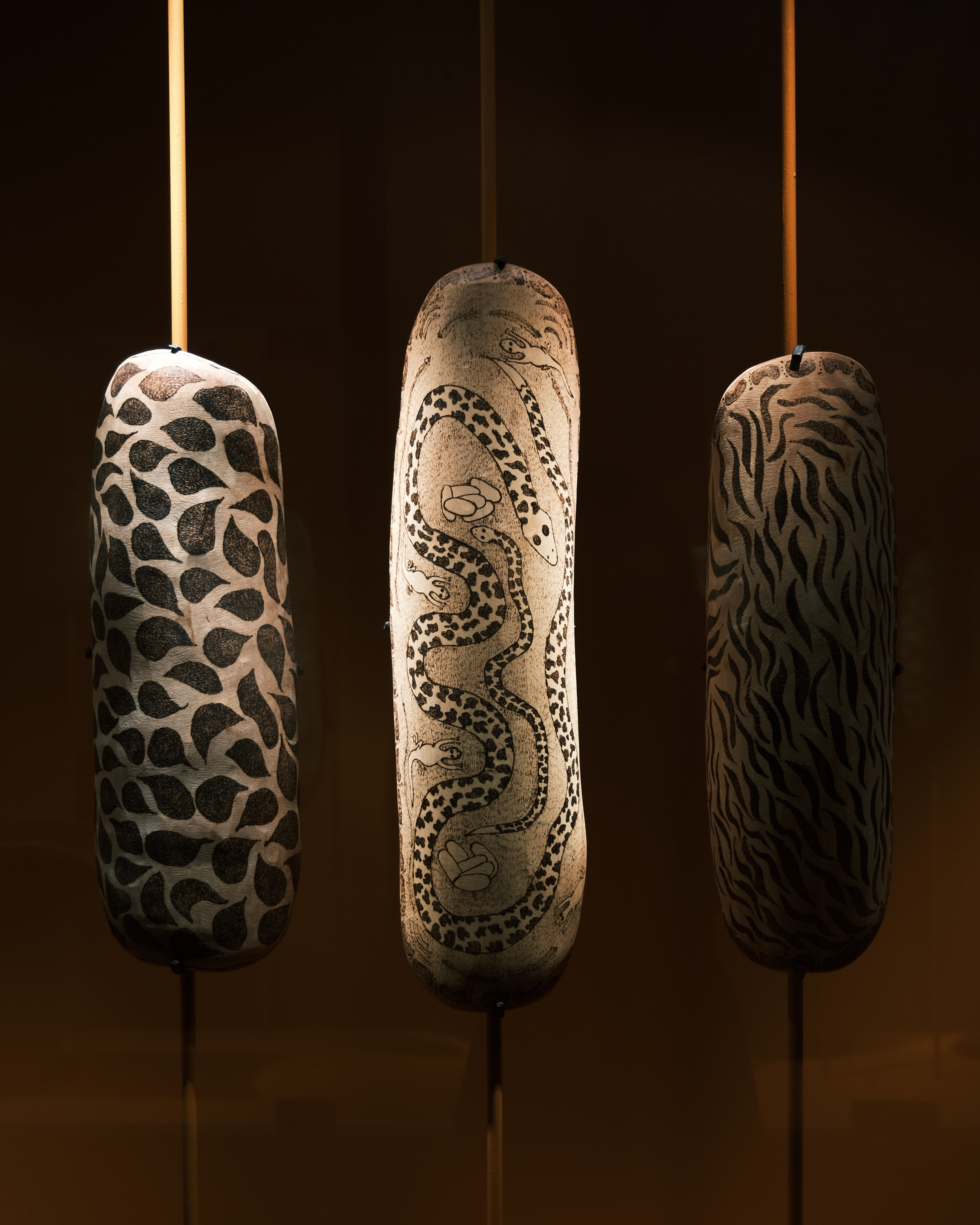Exhibition Insight... Minymangku Punu Palyani (Women Doing Punu)
Cynthia Burke, Tinka (sand goannas), 2021, Itara (River Redgum). Photo: Sam Roberts.
Punu (woodcarvings) have always been a part of Aṉangu culture. Traditionally, punu bowls were carved for practical purposes like collecting food and carrying children (piti), digging and scooping (wira), carrying water (mimpu) and winnowing and sifting grass seeds (kanilpa). Punu bowls continue to be made by Aṉangu women and are poker-etched with walka (designs) depicting Tjukurpa (the Aṉangu creation stories) and Ngura (home/country). This exhibition showcases how the highly skilled female punu artists from across the Central and Western Desert regions have revived old traditions while carving out an artistic niche for themselves.
L-R: Dianne Strangways, Piti – Collecting Bowl, 2019; Dianne Strangways, Kanilpa - Winnowing Bowl, 2019; Dianne Strangways, Piti – Collecting Bowl, 2019. Photo: Tamara Mascarenhas.
While many of these artists are faithful to traditional carving styles in their work, creating time-honoured practical objects, others are continually experimenting with the artform through either figuration or by making abstract sculptural works. Dianne Strangways is a Pitjantjara woman from Indulkana in the APY Lands. Her distinctive style of pyrography, created using a ‘pyro pen’, has a contemporary touch compared to the work of senior artists. Likewise, Ngaanyatjatjarra artist Cynthia Burke takes a very different approach through her spectacular burnt and hollowed trunk carving, seen for the first time in this exhibition. The corresponding mimpu, a deep bowl made for carrying water, is characteristic of traditional punu as it responds to the natural structure of the tree, made from carving a burl. Cynthia, alongside fellow Ngaanyatjatjarra artist and good friend Lena Dawson are two of Maruku’s foremost up and coming punu artists who find their inspiration in the abstract form of trees. Cynthia and Lena, who are both based in Warakurna, learnt how to make punu from their mothers, aunts and grandmothers. Each of their practices carry on the traditions of the Tjurkurpa.
Cynthia Burke, Kapi Tjukurpa (detail), 2020, pyropen etching on Desert Bloodwood. Photo: Sam Roberts
Like Cynthia and Lena, Pitjantjatjara artist Lulu Cooley’s punu skill and style evolved after watching her mother and aunties work as early as the 1960s. Lulu is a Minyma Ulkumunu, a senior Aboriginal woman who is an accomplished carver renowned for her distinctive, scallop design representing tali (sand dunes). Lulu’s piti and wira bowls are displayed beside those of two more senior Aboriginal women, Narelle Holland, a Ngannyatjarra artist from Mantamaru, Northern Territory and Yangi Yangi Fox, a senior Pitjantjatjara woman based in Kalka in the Aṉangu Pitjantjatjara Yankunytjatjara (APY) Lands, South Australia. Lulu’s husband Billy Cooley, a master carver, helps Lulu to chisel her bowls. They are based near the Maruku Arts centre in Mutitjulu (at Uluru-Kata Tjuta National Park).
Another husband-and-wife duo, following in the footsteps of Billy and Lulu, are Errol Evans and Tanya Singer who live near Indulkana. In late-2019 Tanya and Errol travelled to Adelaide courtesy of Country Arts SA. During their time, they visited JamFactory where they met Creative Directors Daniel To and Emma Aiston and toured the four studios. A Yankunytjatjara artist, Tanya creates works with contemporary simplicity, wielding a sophisticated use of materials, textures and mark-making. Tanya represents the next generation of punu artists handcrafting sleek and contemporary wooden objects which are left bare to reflect the forms and patterns made by nature. Likewise Warakurna-based artists Lillian Golding and Dianne Ungukalpi Golding maintain a minimal, ‘naked’ approach to their bowls, letting the beauty of the wood’s natural patina stand alone.
Minymangku Punu Palyani (Women Doing Punu) is showing in Gallery Two, JamFactory Adelaide until 28 November 2021 as part of Tarnanthi 2021, the Art Gallery of South Australia’s Festival of Contemporary Aboriginal and Torres Strait Islander Art.



